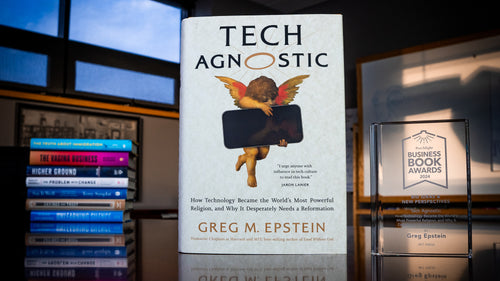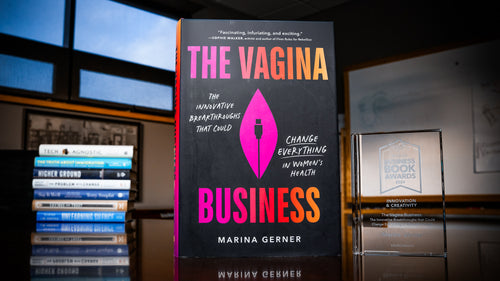Excerpt from Why Johnny Can't Brand
 The following excerpt is taken from the introduction to Why Johnny Can't Brand: Rediscovering the Lost Art of the Big Idea by Bill Schley and Carl Nichols, Jr. The authors show that successful branding is not charisma or warfare, or millions spent on entertaining ads starring dancing chimpanzees or cowboys herding cats, but the ability to differentiate a product and give consumers a real reason to pay attention. It's about making the product the star.
The following excerpt is taken from the introduction to Why Johnny Can't Brand: Rediscovering the Lost Art of the Big Idea by Bill Schley and Carl Nichols, Jr. The authors show that successful branding is not charisma or warfare, or millions spent on entertaining ads starring dancing chimpanzees or cowboys herding cats, but the ability to differentiate a product and give consumers a real reason to pay attention. It's about making the product the star.
INTRODUCTION
"HOUSTON (AND NEW YORK, CHICAGO,
BOSTON) . . . WE HAVE A PROBLEM"
Most companies speak in generalities that "roll off the human understanding like water off a duck's back." But give me one Dominant Selling Idea--and that brand will pierce the fog like a headlight on a train.
Guru Mahatma Mahareshi "Mahesh" Goldberg
Some statistics you can't believe until you see them for yourself. For example, nobody in Manhattan, where everybody's thin, really believes that almost 60 percent of the population of America--winner of two world wars, sole superpower, and home of the brave--is now, officially, obese. But they do after they spend a day at Six Flags.
So when we tell CEOs and senior executives that there's a similar epidemic in American branding that's so acute, seven out of ten companies are going to market in the most cluttered conditions in history with formless positioning and flabby claims devoid of any differentiating punch; that record billions of dollars each year are being thrown out the window like confetti because of it; and that dominant brand identity for good companies has become American industry's #1 most valuable wasted asset, they don't always accept it.
Then we tell the following story. It illustrates the basic marketing problem so many good companies still haven't solved.
The Day Marketing Jumped the Guard Rail
A few short years ago, at the end of the millennium, there was a business phenomenon called the Dot-Com Disaster, a time when grown-ups gave billions to twenty-three-year-olds to start Internet companies without any visible demand or customers. If you were investing back then, you probably have no recollection of it now, something that's normal after a really bad accident. This era had a carry-over effect on the world of marketing. It reached a peak on January 30, 2000, a historic day. As it unfolded for all to see like a pile-up on a California freeway, it was miraculous. By God there it was, the grand finale--the end of business sanity as we know it--the ads for Super Bowl XXXIV on TV. By the second half, it was clear that if the state of American branding didn't improve soon, someone ought to write a book.We gave it a multiyear grace period.
It didn't.
For those of you this past year who saw the flatulent Budweiser Clydesdale lift his tail, ignite a gaseous emission and blast the makeup off the blonde's face--and wondered how that triggered a thirst for Bud--or who asked the question after seeing $75 million worth of advertising, "I know the Duck quacks but what does the company do?"--the classic examples from that historic Super Bowl are as illustrative today as they were then . . .
Singing Chimps and Rioting Brides
On that January day, you could watch as company after company gleefully wasted $4.2 million per minute of their shareholder's money and opportunity under the tutelage of the world's most respectable advertising agencies. Entertainmentwise it was an A+. We saw the famous sock puppeting "If You Leave Me Now" by Chicago, mourning the fact that his master walked to the pet store instead of using the Web to order his Kibble. We saw cowboys herding cats on the open range for twenty-seven seconds while cowpoke after cowpoke tried to top the same cat-herding joke; until finally, in the last three seconds, the announcer revealed it was a commercial for EDS, who should now earn our business in integrated computing. Another appeal for our wallet share showed a dozen brides in white gowns start a fistfight at the stationery store because someone picked the same invitation. Best of all, we saw a dancing chimpanzee in an E*Trade T-shirt next to a couple of sad-sack investors who actually said, "Well, we just wasted our two million dollars. Now what?" Must have cast the client in that one.
In every ad, the average time for DOM (delivery of mirth) was twenty-five seconds. Average time of sales message: five seconds. Name on screen: two. Needless to say, viewers were highly amused, but almost no one could match an ad to a product. And no one cared. So much for 250 million bucks. So much for marketing execs making 500,000 dollars a year who are supposed to know better. The epidemic of sense-defying "branding," building for years, reached a crescendo that day. Soon afterward, the dot-com bubble burst. There was a lot of blame. And overnight, in the boardrooms of companies from coast to coast, a word that had been the holy grail of the "new economy" became a word that could get you fired: branding.
There is irony too. Marketing departments were slashed, even closed altogether--just when companies with more competition than ever in shrinking markets needed them most.
One Small Detail: It Ain't Branding
Here's what they missed:
What they had been spending billions on and calling "branding" wasn't branding. It was entertaining. It was goofy names and logos. It was spending huge amounts to put cute words and pictures in the path of millions of consumers. Anything to get noticed. Anything to make a BANG!
But it had virtually nothing to do with creating real brands. Not the way the great Brand Titans who invented it meant branding.And today, in spite of all the lessons that should have been learned, seven out of ten companies still operate on the verge of brand oblivion epitomized by that disaster.
Yet the cure is nearly always waiting right under the nose of any company who looks for it, and then follows the simple and practical rules in the pages ahead.
Real Branding
This book is about removing the obstacles keeping "Johnny" and so many others from uncovering the Big Idea inside their brands.
That means it's about three things:
It's about thinking of brands in a surprisingly easy, everyday way that makes branding intuitive, demystifying the process of finding and expressing your big idea so that after you read about it, you can actually do it.
It's about transforming your business by putting your brand on a very focused kind of diet-and-fitness program--a super-effective regimen that will break the addiction to shallow, sugary conceits, melt the flab of puffy claims, and lean you down to the muscle that can make you a #1 brand.
And ultimately, it's about the fact that you really can create an entire turnaround for your strategy and position in about eight weeks--a workable, believable, #1 position in the minds of your targets--whether you're Ford Motors or Frankie's Lawn & Garden. In other words, it's about real brands--real brands versus the empty shells that are assets waiting to happen. Brands based on a real motivating difference that culminates in a Dominant Selling Idea--the big idea inside the message of every great, lasting brand. A real brand sets you up to be #1 in the specialty you choose. It grabs a place in the prospect's mind that no competitor can share, puts you on the short list for RFPs, and gives you a head start on every sale . . .plus one more thing: the internal by-product. A real brand brings new energy to any company that acquires it, enabling everyone to focus and march in the same direction.
This is anything but marketing fluff. You'll find that it's applied sales physics. Take, for example, the seventh axiom in Chapter 4: "If you build a better mousetrap, absolutely no one gives a s - - t." In fact, they secretly hate you for disrupting their impossible schedules with a new concept they have to learn about, decide if they can trust, and teach others to implement. No one ever sees what you see until you show them and sell them.
The only thing that can vault your brand over this firewall without a $50 million ad budget is the same as it was in the ancient time of Demosthenes--an idea--taken from a very special category of ideas. To be precise, a selling idea. We'll show you exactly why a selling idea is different from all other kinds of ideas and how to identify the one big idea for your brand in just forty working days.
The Sexiest Thing of All
Fear not. No one demands that you be dull. Creativity, color, and fun will always be the body of standout marketing and communication. But the heart is the selling idea. Idea first, entertainment second--or no real brand. Otherwise, your expensive advertising and brochures will be like a new sports car delivered without an engine--pretty, but with no means of driving itself into the mind of the customer. When you follow the simple advice in the pages ahead, you'll understand how to do the hardest, but most critical thing in marketing: make your product the star, not a sock puppet or a crowd of cats. Because in the end, the sexiest thing of all is increased sales.
Use Only as Directed
Please heed this advice: like any good self-improvement process, Part One is the crucial part, even though it's not the action plan or specific steps you might think of as the process itself. That comes in Part Two. Part One is where we figure out how much or how little we're really like "Johnny." We'll see the miscues and omissions that keep Johnny from finding his real #1 brand. And we'll get the rules and directions, laced with anecdotes and success stories we need to buy in, psych ourselves up, and take action. Because all coaches and psychologists know the most important phase of the program is . . . you ready . . . the mental one.
Not a new concept, we know, but it's 80 percent of this game, too. The eight-week positioning process succeeds more by adjusting how you think than any other factor. Bottom line: the "how-to" program at the end of this book is useless without understanding all the rules and principles that begin a few pages from now. They're the brains that move the muscle of your lean, real brand.
Found Money
What you will find at the end of this book is money. This is a guarantee. At the very least, found money in the form of better market awareness, better close ratios, and increased sales on your tight budget. At most, a transformation of your people and your business from the inside out: new vision, new purpose, new energy, new prospects, new products, and new asset value for the whole enterprise based on the galvanizing power of a Dominant Selling Idea. We've seen this transformation happen time and time again, and it can happen to you. It's the highest-markup, lowest-cost, asset-enhancing endeavor that any business can make because all it takes is a few weeks of focus and a few blank sheets of paper to write on.With a yield like that, who wouldn't try?
This excerpt used by permission of Bill Schley, author of Why Johnny Can't Brand: Rediscovering the Lost Art of the Big Idea. Visit him online at www.davidid.com.



